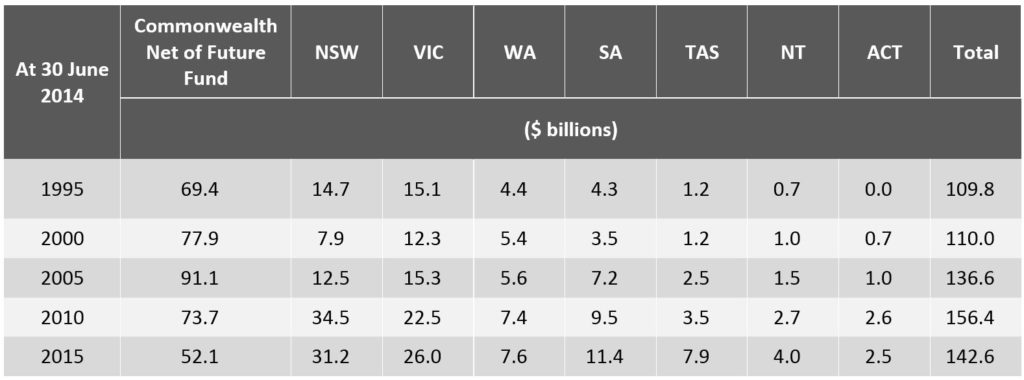
FUTURE SHOCK: HIDDEN GOVERNMENT DEBT
- On 16/06/2016
All Australian Governments are battling to balance their annual budgets. The main theme of the Parties leading into the current Federal election is how best to set the levels of taxation and expenditure. The decisions are inherently difficult and the Coalition and Labor have both retreated from positions of returning the Budget to surplus in the near future.
One of the largest government debts held are the unfunded public-sector superannuation liabilities. These arise from legacy defined benefit superannuation funds where the government holds back on making contributions and only meets the liability when the benefits are paid. Effectively, the bill is passed onto future generations. Fortunately, most of these funds were closed in the last 25 years (some quite recently) so the number of people with defined benefit entitlements reduces every year. However, the value of liabilities has continued to grow significantly as shown in the table.
Rice Warner’s research shows that the total net value of current unfunded super liabilities was $143 billion at June 2015. This is after allowing for the Future Fund’s assets of $117.2 billion, which cover about 70% of the Federal Government’s accrued defined benefit liability.
Growth of unfunded liabilities over last 20 years

If these liabilities continue to be unfunded, future governments and taxpayers will have to finance the payment of superannuation lump sums and indexed pensions to retiring public-sector employees.
FUTURE FUND
The performance of the Future Fund has meant that the Commonwealth’s unfunded liability has remained relatively stable over the last few years.
However, the projected earnings of the Future Fund in this low-interest environment means that the Commonwealth’s net unfunded liability may keep growing. Based in part on Federal Budget papers, the shortfall between the Commonwealth’s unfunded liability and the Future Fund’s projected earnings is projected rise unless the future fund earns a return of at least 4.8% p.a. from now to 2019.
By 2019, the Commonwealth’s gross unfunded liability (excluding the Future Fund) is expected to reach $193.7 billion – blowing out by $24.4 billion from 2015.
STATE BY STATE
Queensland is the only state or territory to currently have a fully-funded defined benefit super scheme (QSuper). It went into a small temporary deficit during the GFC but the government fixed this by making an in specie contribution of the major Brisbane motorways, which were later sold by the fund at a handsome profit.
Management of QSuper’s surplus is a delicate balancing act. The current surplus from strong fund earnings has allowed the Queensland Government to suspend contributions to its defined-benefit scheme for five years (a contribution holiday). In addition, the Queensland Government is now withdrawing some of the assets from the fund, to finance infrastructure spending and reduce explicit debt.
By definition, any reduction in surplus increases the risk of a deficit arising in the future. An unfortunate characteristic of defined benefit deficits is that the economic scenarios which cause a deficit to emerge tend to be the scenarios in which funding a deficit is most challenging.
HOW ARE THE UNFUNDED LIABILITIES VALUED?
A simple definition of an unfunded liability is a debt that cannot be repaid with the assets and earnings of assets allocated to that debt. Lower investment returns on the available assets mean that Australia’s unfunded superannuation debt will grow unless government contributions to the funds are increased and/or investment returns are stronger than anticipated.
All defined benefit funds must be valued by an actuary.
The future liabilities must be discounted to present values using a discount rate. Historically, the rate on ten-year government bonds has been used as the discount rate. However, in this low interest era, this has led to a large increase in the liabilities. Our database of State defined-benefit funds shows that four now use a discount rate of 3%.
The liabilities also allow for a future rate of salary growth. If public servants get pay rises larger than expected, the liabilities will rise.
Some of these funds pay indexed pensions to retiring public servants. The values of these will grow if longevity improves more rapidly than currently expected.
Other risks include the extent to which liabilities might be increased by any future public sector headcount reduction exercises, which can involve favourable defined benefit entitlements for those who have to retire early.



